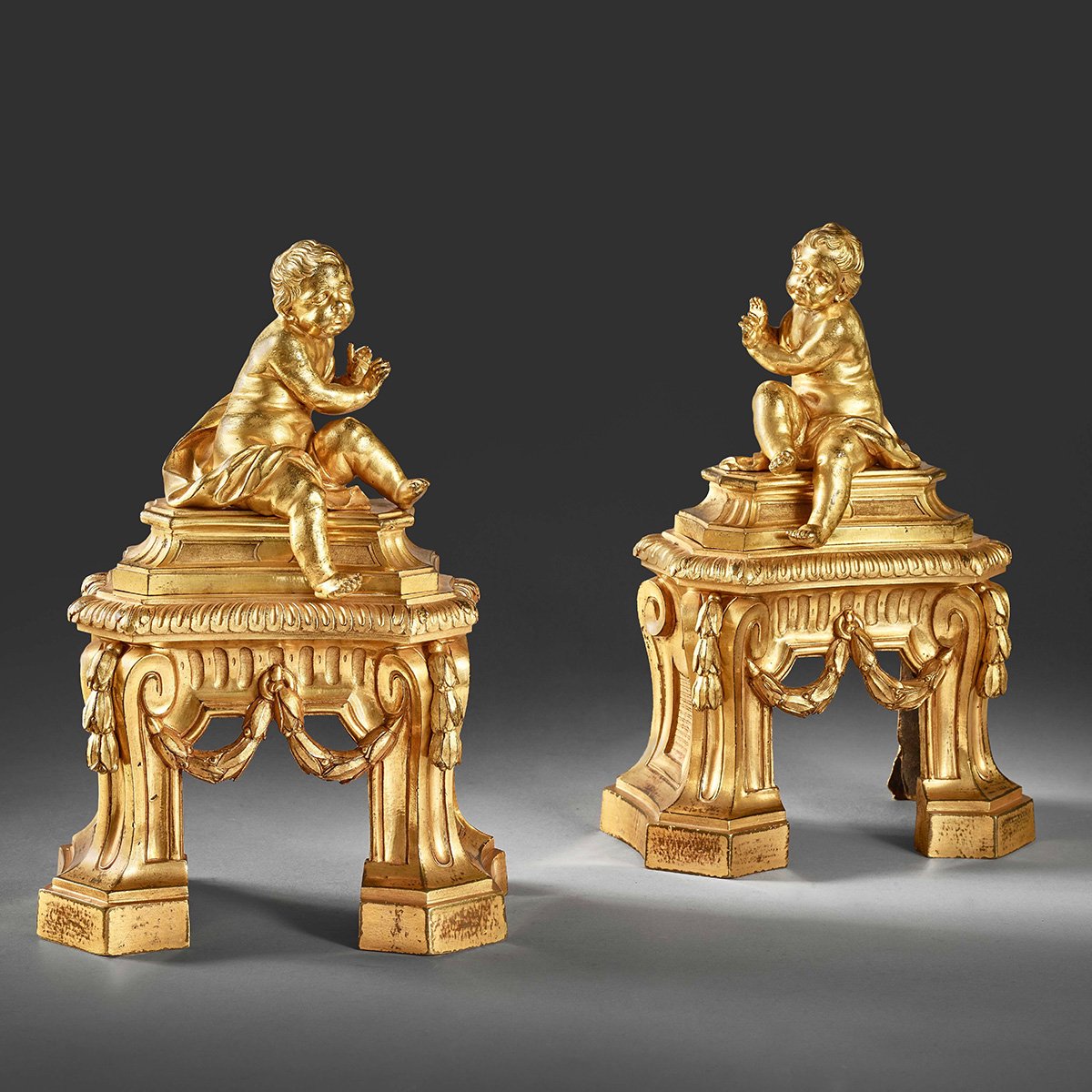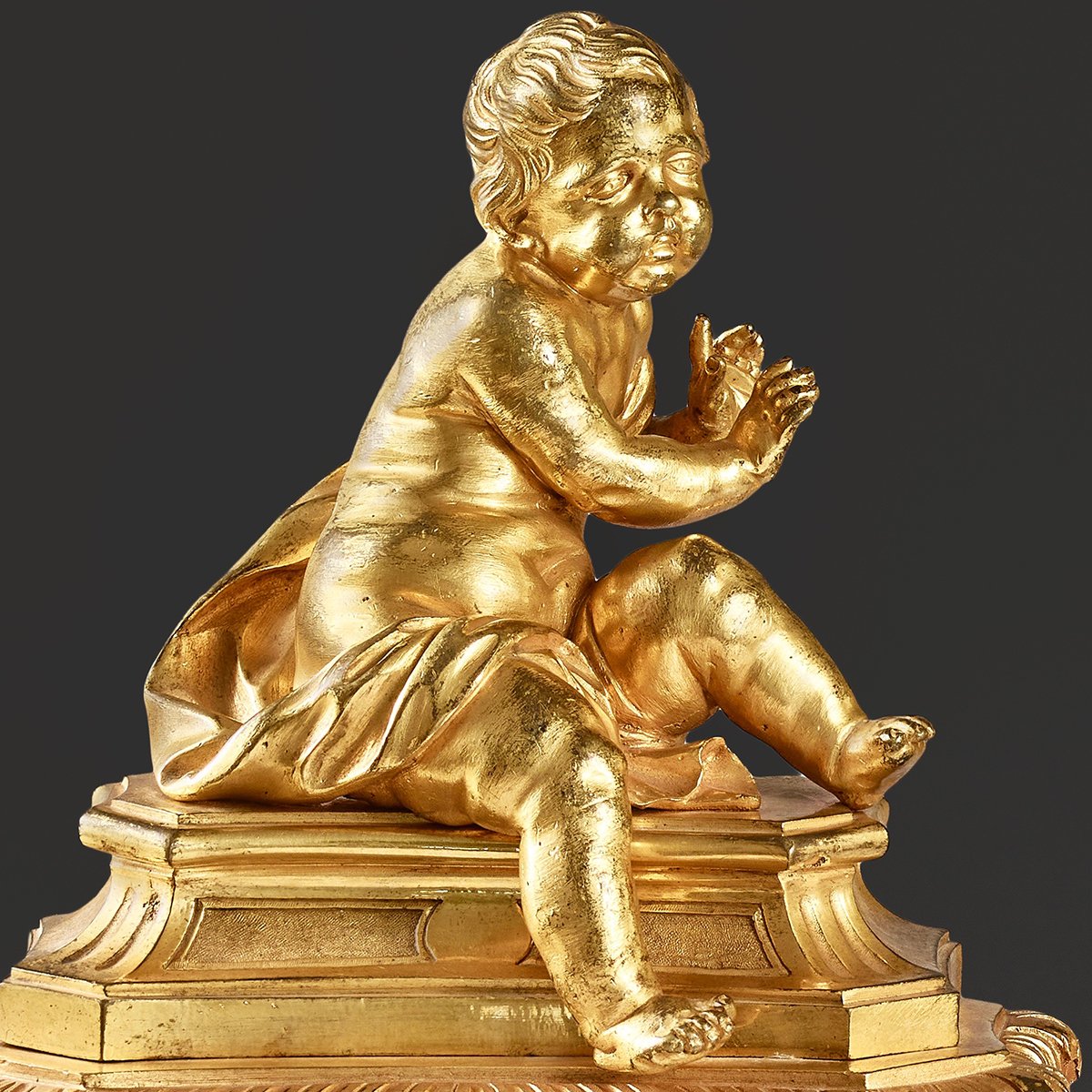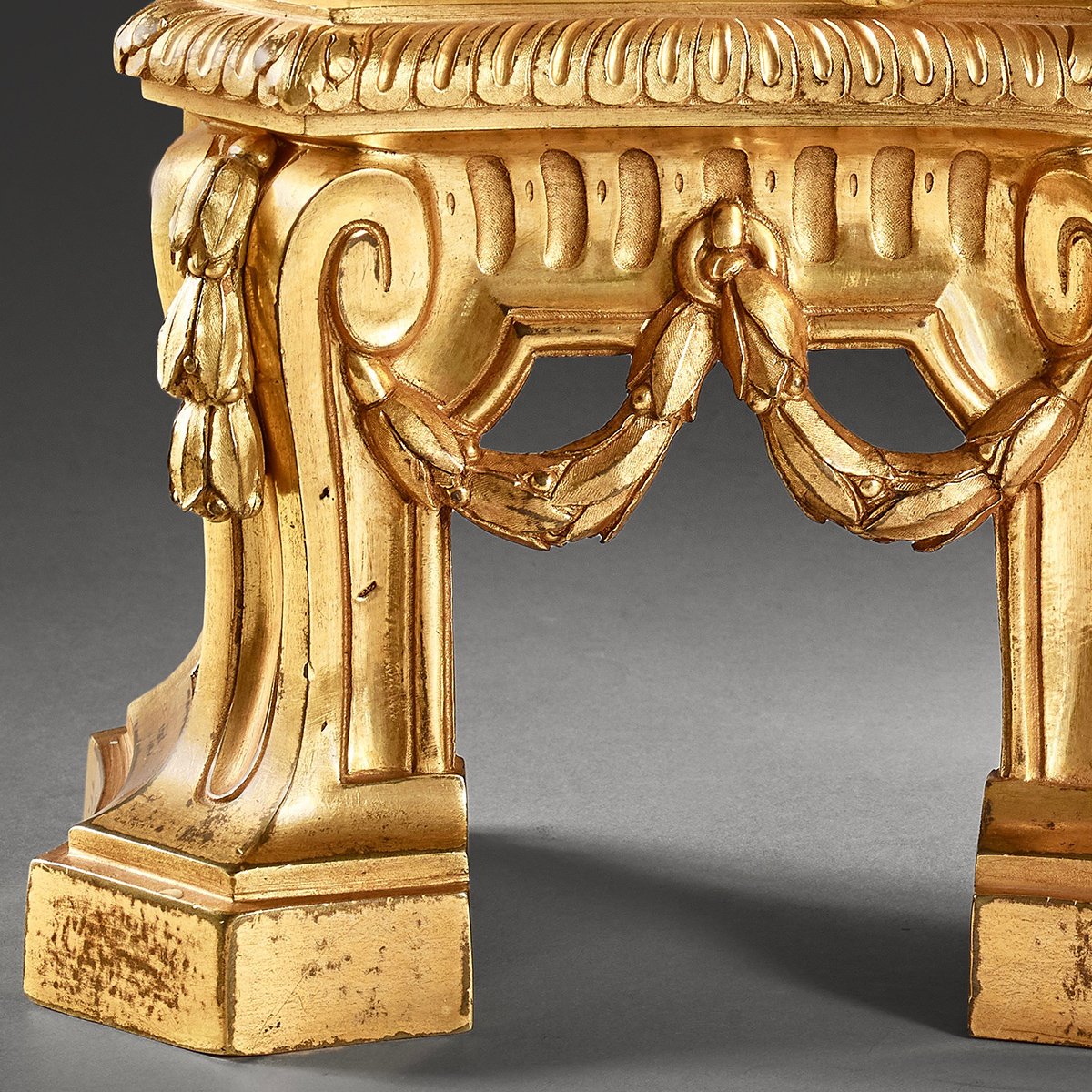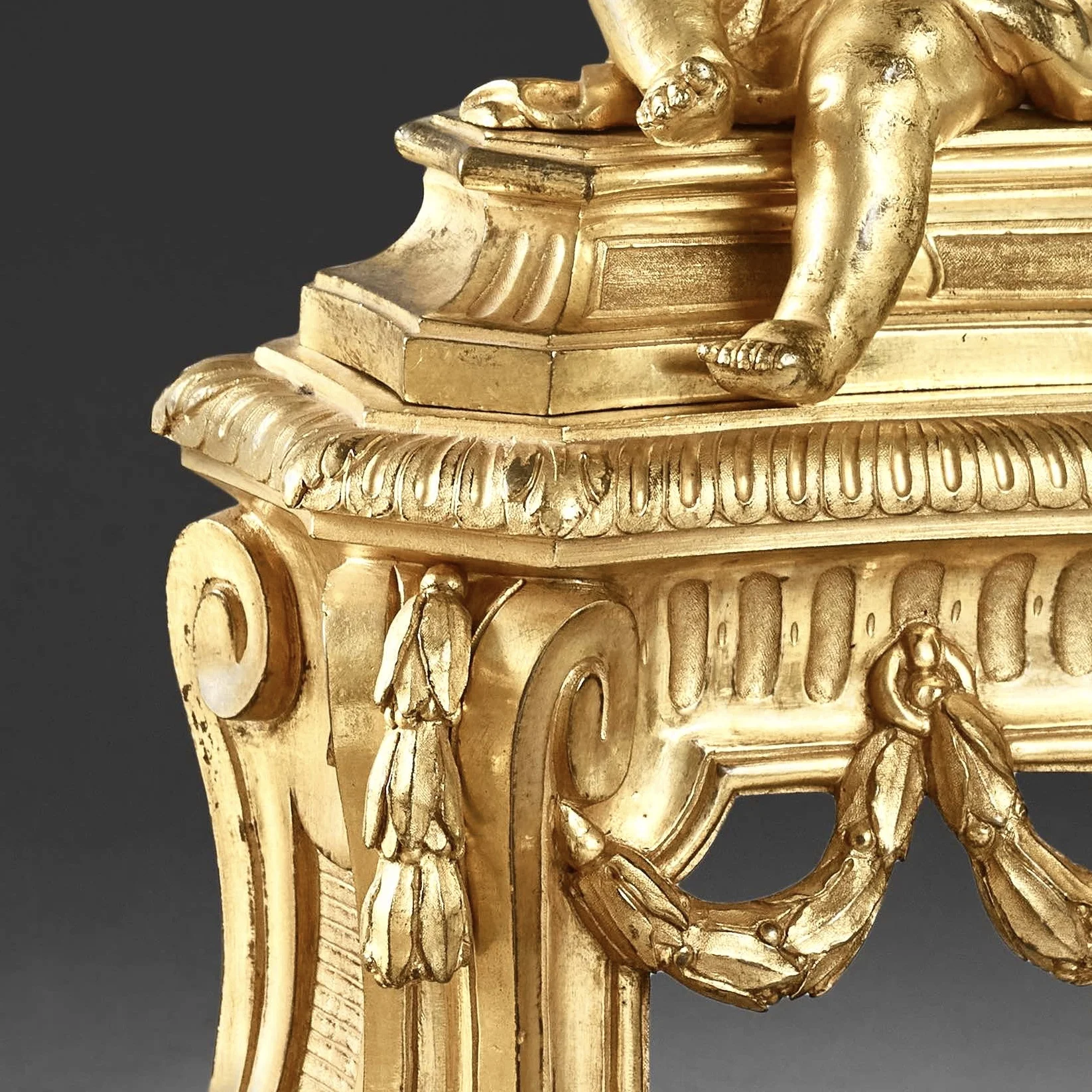Pair of firedogs with chilly putti
- Description
- Histoire
France, Transition period, circa 1760
Attributed to Philippe Caffieri (1714−1774)
Chased and gilt bronze
Height: 32 cm – 12 ½ inches
Length: 21 cm – 8 inches
Depth: 13 cm – 5 ¼ inches
Comparable example:
- Attributed to Philippe Caffieri, Pair of firedogs with children, circa 1770, Stockholm, Royal Palace, Royal Swedish Collections (inv. HGK 97).
- Louis Prieur, Drawing, 1770, private collection, Sotheby’s Monaco sale, November 26, 1979, no. 605.Ottomeyer, idem.
Presumably identical example, 18th-century collections:
- On November 18, 1771, similar firedogs were delivered to the Prince de Condé for his room in the Palais Bourbon, for the sum of 410 livres:
« On the mantelpiece and opposite, two mirrors of two pieces each (…), between the two crosspieces a mirror…), a fire decorated with two children warming themselves, on their base gilded in ground gold, with pesle, tweezers and pincers, trimmed with their knob chased in ground gold copper.
Archives Condé, A.C. 7, Y, quoted in Hans Ottomeyer, Petter Pröschel, Vergoldete Bronzen: Beiträge zur Geschichte und Technik der Bronzearbeiten, zu Künstlern und Werkstätten, T. I, München, Klinkhardt & Biermann, p. 199.
In finely chiseled and gilt bronze, these firedogs are each adorned with a little child, seated slightly to the side – one leg bent against the stomach and the other extended – with arms slightly outstretched and palms open, as if seeking to warm themselves by the fire. They are naked except for a loose drape covering their waist.
The children are seated on an octagonal pedestal of trapezoidal shape, which is decorated on its broadest faces with a simple cartouche featuring a circular motif at its center. This pedestal surmounts a platform that follows its form, itself adorned with a frieze of channels.
The base of the firedogs draws on the “Greek style” repertoire: each foot is embellished at the corners with a volute in the form of a triglyph, from which hangs a vertical laurel garland. These feet are united at their top by a frieze with a geometric fluted pattern and are connected to one another by a laurel garland fastened at the center by a ring.
The theme of childhood in 18th-century decorative arts
In the 18th century, the child began to assume an increasingly important role in society. In an era of profound transformation – marked by advances in science, medicine, literature, and a renewed closeness to nature – the child came to be at the center of political, moral, and social concerns. The education of the young was seen as a matter of considerable importance for the common good. Indeed, this education implied a vision for the future of society, in which tomorrow’s adults would be called upon to create an ideal world.
The publication of Jean-Jacques Rousseau’s (1712-1778) Émile, or On Education in 1762 fit squarely within Enlightenment thought. This work marked a turning point in the way educators viewed the child: no longer seen as an incomplete being, the child was recognized as a full human being – idealized and brimming with hope.
This Rousseau-inspired view of childhood, imbued with greater naturalness and sensitivity, celebrated familial sentiment. The century saw the emergence of paintings uniting parents and children, where affection and tenderness were clearly evident. Depictions of Christ in Virgin and the Child scenes grew more realistic, with more natural adjustments in posture and gaze. The bourgeoisie began to care for their own children, and although the aristocracy still entrusted the education of their offspring to nannies, it too started moving in that direction.
This evolution in the perception of childhood left its mark on 18th century decorative arts, where it became omnipresent. The child emerged as a major subject, appearing on a variety of media – from Sèvres porcelain to wood paneling and even gilt bronzes, as exemplified by this pair of firedogs.
The decorative repertoire and the subject depicted on these firedogs are reminiscent of a drawing by Louis Prieur from 1770, in which one can see a child on a pedestal adorned with laurel garlands. Generally, the theme of children and putti scenes was intended for small cabinets, in contrast to that of deities, which was more often featured in grand reception salons.
Philippe Caffieri (1714-1774)
Belonging to one of the most prominent families of bronze makers of the 17th and 18th centuries, Philippe Caffieri was the son of Jacques Caffieri (1678-1755), a Sculpteur et Ciseleur Ordinaire du Roi. He is known as “the Elder” to distinguish him from his younger brother, Jean-Jacques (1725-1792), a sculptor renowned for his busts.
Philippe Caffieri first studied with his father and attended the drawing school at the Académie de Saint-Luc. In 1743, his parents succeeded in transferring to him the privilege heretofore granted to his mother – that of “gilder, engraver, and damascener following the Court” – to facilitate his establishment. In 1747, he entered partnership with his father. In 1754, after becoming a Master sculptor, he was named a member of the Académie de Saint-Luc and later became a jury of the corporation. Upon his father’s death in December 1755, he became the owner of the workshop on Rue Princesse, inheriting the family business’s stock of models. A month later, on January 16, 1756, he also became a Master caster in earthenware and sand casting without having to produce a reception piece – simply because his father had been a Master caster himself.
Philippe Caffieri appears to have been an early proponent of the Antique style. In his compositions one finds only vague reminiscences of the old genre: console-like movements, clock frames with animal and dial motifs topped by a monkey or a young savage (as seen in the work of Jean-Joseph Saint-Germain (1719–1791)), palmettes or scrolls evoking Rocaille or the plissé style, with few floral elements and a certain disdain for frivolity.
Through his style and production – part of which is signed and dated between 1756 and 1771 – he occupied in the new taste a position analogous to that of his father during the Rocaille period. He worked not only for the Garde-Meuble but also for the Bâtiments du Roi, and his clientele included the Marquis de Marigny, Madame de Pompadour, the collector Pierre Louis Paul Randon de Boisset, François Boucher, the Prince de Condé, the King of Poland, as well as several cathedral chapters that commissioned him to create significant gilt bronzes.
Bibliography:
- Hans Ottomeyer, Petter Pröschel, Vergoldete Bronzen: Beiträge zur Geschichte und Technik der Bronzearbeiten, zu Künstlern und Werkstätten, T. I, München, Klinkhardt & Biermann, p. 199, pl. 3−14−6, avec un dessin préparatoire attribué à Louis Prieur, vers 1770.
- Pierre Verlet, La Maison du XVIIIe siècle en France, Paris, Baschet & Cie Éditeurs, 1966, pp.270–271.
- Pierre Verlet, Les Bronzes dorés français du XVIIIe siècle, Paris, Éditions Picard, 1987, pp. 193- 194.



